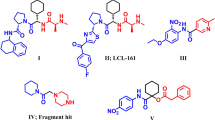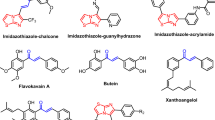Abstract
The current study included density function theory calculations, molecular docking studies, SeeSAR analysis, molecular dynamics studies and assessments of the absorption, distribution, metabolism, excretion and toxicity properties (ADMET) of N-(4-acetyl-4,5-dihydro-5-(7,8,9-substituted-tetrazolo[1,5-a] acetamides of -quinolin-4-yl)-1,3,4-thiadiazol-2-yl) that is 4a-j. These derivatives have previously been identified as anticancer agents against a human cervical cancer cell line. The primary goal of this work is to assess the potential of these derivatives as caspase-3 inhibitors using extensive computational analysis. The binding interactions of these compounds with caspase-3 protein (PDB ID: 4JJ8) were found and all compounds demonstrated strong binding interactions within the active pocket of the targeted protein. Interestingly, derivative 4e showed maximum potential and was found to have the strongest interactions with a binding energy of −29.6 kJ/mol. Furthermore, the findings were discovered to be in comparison with the reference drug, adriamycin (−26.5 kJ/mol). In addition to molecular docking, ADMET and simulation studies were carried out to determine their safety profiles, with the results correlating to molecular docking investigations. Finally, SeeSAR analysis and molecular dynamics simulation investigations were carried out. In conclusion, this molecule may be a “lead candidate’ for making a more powerful caspase-3 inhibitor that can be used in tumors where the levels of caspase-3 are aberrantly high.










Similar content being viewed by others
Availability of data and material
N/A.
Code availability
ChemDraw Ultra 12.0, Gaussian 09, GaussView 5.0, Discovery Studio (2020).
Change history
02 July 2022
Springer Nature’s version of this paper was updated: The name of the University in the Acknowledgements was changed from “Abdul Rahman“ to “Abdulrahman”.
References
Abbas Z, Rehman S (2018) An overview of cancer treatment modalities. Neoplasm 19:139–157
Zitvogel L, Apetoh L, Ghiringhelli F, Kroemer G (2008) Immunological aspects of cancer chemotherapy. Nat Rev Immunol 8:59–73
Kemp G, Rose P, Lurain J, Berman M, Manetta A, Roullet B, Homesley H, Belpomme D, Glick J (1996) Amifostine pretreatment for protection against cyclophosphamide-induced and cisplatin-induced toxicities: results of a randomized control trial in patients with advanced ovarian cancer. J Clin Oncol 14:2101–2112
Waks AG, Winer EP (2019) Breast cancer treatment. JAMA 321:316
Waggoner SE (2003) Cervical cancer. The Lancet 361:2217–2225
Pandey V (2021) Caspase-3 inhibition prediction of pyrrolo [3, 4-c] quinoline-1, 3-diones derivatives using computational tools. Indian J Pharm Sci 83:504–514
Devarajan E, Sahin AA, Chen JS, Krishnamurthy RR, Aggarwal N, Brun AM, Sapino A, Zhang F, Sharma D, Yang XH, Tora AD (2002) Down-regulation of caspase 3 in breast cancer: a possible mechanism for chemoresistance. Oncogene 21:8843–8851
Shi Y (2002) Mechanisms of caspase activation and inhibition during apoptosis. Mol Cell Mar 9:459–470
Hu Q, Peng J, Liu W, He X, Cui L, Chen X, Yang M, Liu H, Liu S, Wang H (2014) Elevated cleaved caspase-3 is associated with shortened overall survival in several cancer types. Int J Clin Exp Path 7:5057
Marganakop SB, Kamble RR, Hoskeri J, Prasad DJ, Meti GY (2014) Facile synthesis of novel quinoline derivatives as anticancer agents. Med Chem Res 23:2727–2735
Brauch S, van Berkel SS, Westermann B (2013) Higher-order multicomponent reactions: beyond four reactants. Chem Soc Rev 42:4948–4962
Kitchen DB, Decornez H, Furr JR, Bajorath J (2004) Docking and scoring in virtual screening for drug discovery: methods and applications. Nat Rev Drug Discov 3:935–949
Sharma S, Basu A, Agrawal RK (2013) Pharmacophore modeling and docking studies on some nonpeptide-based caspase-3 inhibitors. Biomed Res Int 2013:1–15
Marahatta AB (2020) DFT study on electronic charge distribution and quantum− chemical descriptors for the kinetic stability of vanadium aquo complex ions [V (H2O) 6] 2+ and [V (H2O) 6] 3+. IJPSAT 22:67–81
Frisch MJ, Trucks GW, Schlegel HB, Scuseria GE, Robb MA, Cheeseman JR, Scalmani G, Barone V, Mennucci B, Petersson GA, Nakatsuji H, Caricato M, Li X, Hratchian HP, Izmaylov AF, Bloino J, Zheng G, Sonnenberg JL, Hada M, Ehara M, Toyota K, Fukuda R, Hasegawa J, Ishida M, Nakajima T, Honda Y, Kitao O, Nakai H, Vreven T, Montgomery JJA, Peralta JE, Ogliaro F, Bearpark M, Heyd JJ, Brothers E, Kudin KN, Staroverov VN, Kobayashi R, Normand J, Raghavachari K, Rendell A, Burant JC, Iyengar SS, Tomasi J, Cossi M, Rega N, Millam JM, Klene M, Knox JE, Cross JB, Bakken V, Adamo C, Jaramillo J, Gomperts R, Stratmann RE, Yazyev O, Austin AJ, Cammi R, Pomelli C, Ochterski JW, Martin RL, Morokuma K, Zakrzewski VG, Voth GA, Salvador P, Dannenberg JJ, Dapprich S, Daniels AD, Farkas Ö, Foresman JB, Ortiz JV, Cioslowski J, Fox DJ (2009) in Gaussian 09. Gaussian Inc, Wallingford CT
Azarakhshi F, Khaleghian M, Farhadyar N (2015) DFT study and NBO analysis of conformational properties of 2-Substituted 2-Oxo-1, 3, 2-dioxaphosphorinanes and their dithia and diselena analogs. Lett Org Chem 12:516–522
Ioakimidis L, Thoukydidis L, Mirza A, Naeem S, Reynisson J (2008) Benchmarking the reliability of QikProp. Correlation between experimental and predicted values. QSAR & Comb Sci 27:445–456
Ambure P, Kar S, Roy K (2014) Pharmacophore mapping-based virtual screening followed by molecular docking studies in search of potential acetylcholinesterase inhibitors as anti-Alzheimer’s agents. Biosystems 116:10–20
Walters WP (2012) Going further than Lipinski’s rule in drug design. Expert Opin Drug Discov 7:99–107
Ferreira LL, Andricopulo AD (2019) ADMET modeling approaches in drug discovery. Drug Discov Today 24:1157–1165
Xiong G, Wu Z, Yi J, Fu L, Yang Z, Hsieh C, Yin M, Zeng X, Wu C, Lu A, Chen X (2021) ADMETlab 2.0: an integrated online platform for accurate and comprehensive predictions of ADMET properties. Nucleic Acids Res 49:W5-14
Cousins KR (2011) MOE (Molecular Operating Environment) Version 2016.01. Chemical Computing Group [24]. Computer review of ChemDraw ultra 12.0
Vickers CJ, González-Páez GE, Wolan DW (2013) Selective detection of caspase-3 versus caspase-7 using activity-based probes with key unnatural amino acids. ACS Chem Biol 8:1558–1566
Morris GM, Huey R, Lindstrom W, Sanner MF, Belew RK, Goodsell DS, Olson AJ (2009) AutoDock4 and AutoDockTools4: automated docking with selective receptor flexibility. J Comput Chem 30:2785–2791
Dennington RI, Keith T, Millam J, Eppinnett K, Hovell WL, Gilliland R (2009) GaussView v. 5.0. 9 visualizer and builder. Gaussian Inc, Wallingford, CT
Komanduri R, Chandrasekaran N, Raff LM (2003) Molecular dynamic simulations of uniaxial tension at nanoscale of semiconductor materials for micro-electro-mechanical systems (MEMS) applications. Mater Sci Eng A 340:58–67
Huang J, MacKerell AD Jr (2013) CHARMM36 all-atom additive protein force field: validation based on comparison to NMR data. J Comput Chem 34:2135–2145
Essmann U, Perera L, Berkowitz ML, Darden T, Lee H, Pedersen LG (1995) A smooth particle mesh Ewald method. J Chem Phys 103:8577–8593
SeeSAR version 12.0.1; BioSolveIT GmbH, Sankt Augustin, Germany (2022). https://www.biosolveit.de/SeeSAR/. (Accessed 2 Mar 2022)
Acknowledgements
All authors are thankful to Marganakop and his co-workers for compounds data. We acknowledge Princess Nourah Bint Abdulrahman University Researchers Supporting Project number (PNURSP2022R116), Princess Nourah Bint Abdulrahman University, Riyadh, Saudi Arabia
Author information
Authors and Affiliations
Contributions
S. A. E. and A. A. A. devised and supervised the study plan. M. A., A. S., and A. F. carried out the molecular docking investigations under the direction of G. S. B and A. T. A. The MD simulations and DFTs were performed by S. R. E and H. M. K. The manuscript write up was carried out by S. A. E, M. A, and H. I. U. All authors read and approved the manuscript for publication.
Corresponding author
Ethics declarations
Consent to publish
All authors whose names appear on the submission approved the version to be published.
Conflict of interest
The authors declare no competing interests.
Additional information
Publisher's Note
Springer Nature remains neutral with regard to jurisdictional claims in published maps and institutional affiliations.
Rights and permissions
About this article
Cite this article
Ejaz, S.A., Alsfouk, A.A., Batiha, G.ES. et al. Identification of N-(4-acetyl-4,5-dihydro-5-(7,8,9-substituted-tetrazolo[1,5-a]-quinolin-4-yl)-1,3,4-thiadiazol-2-yl) acetamide derivatives as potential caspase-3 inhibitors via detailed computational investigations. Struct Chem 34, 425–438 (2023). https://doi.org/10.1007/s11224-022-01986-0
Received:
Accepted:
Published:
Issue Date:
DOI: https://doi.org/10.1007/s11224-022-01986-0




